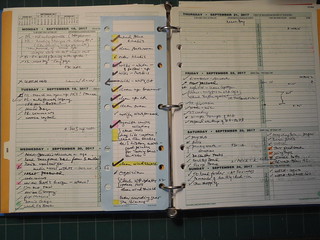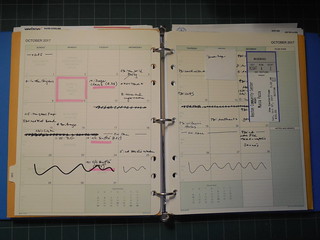I've been using a pre-printed planner for years (I got hooked when a former employer provided them as regular office supplies), and I've learned a few things.
A good journal/planner should look a little messy, maybe a lot.
Nearly printed boxes for days and hours shorten the time to set up my planner for the coming month (it takes me about five minutes), but I still need to do some customizing. Specifically, I need more space for to-dos on the weekends than Day-Timers provides. And tasks will spill out of the neat little boxes, as new information trickles in and new obligations come up.
And that's a good thing. If your week is too tidy, with everything cleanly ticked off, you're not planning to accomplish enough. Whereas in my case, there's almost always too much to do in a week. The wall of to-dos on Saturday is telling me that I'm overcommitted and need to start saying no to things.
Heck, I started making the notes for this blog post last September, and am just now getting something down in digital ink.
Do not hold up looking for the perfect writing instrument to update your planner. Pick up whatever you have on the desk on in your pocket and scribble away. Now, I have started experimenting with color and highlighters to flag important tasks that I've been procrastinating about. But there's no system to my colors—I just grab the first highlighter on my desk that hasn't dried out. (I came by a box of half-used office supplies that I've been using up, but that's a story for a different day.) And if you've got a big, gnarly project that you've just finished, one that's been hanging over your head for a while, go grab a Sharpie and give yourself a plus-size checkmark.
I use my paper planner for the tactical job of getting through the day, getting through the week.
And I have a paper two-page calendar for the month that likewise tells me whether I've got too much planned for the month—or whether I'm going to have a schedule conflict. Sometimes I'll tape a souvenir to the month calendar. Sticky notes help manage a tentative date that I might need to reschedule.
For longer term planning, I made the transition to digital tools some time ago. Transitions plural: I'm now dependent on Trello, with some help from Toodledo for keeping track of recurring tasks.
Actually, when you read to the end of many of the posts about bullet journals, the pragmatic advice comes through: Do what works for you; don't overthink it; all you need is a notebook and a pen to get started.

